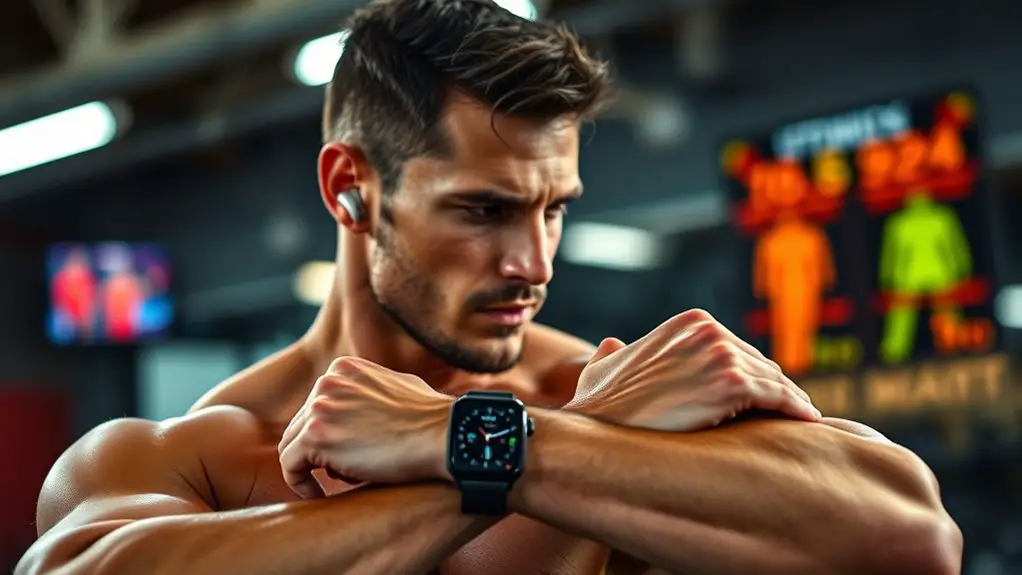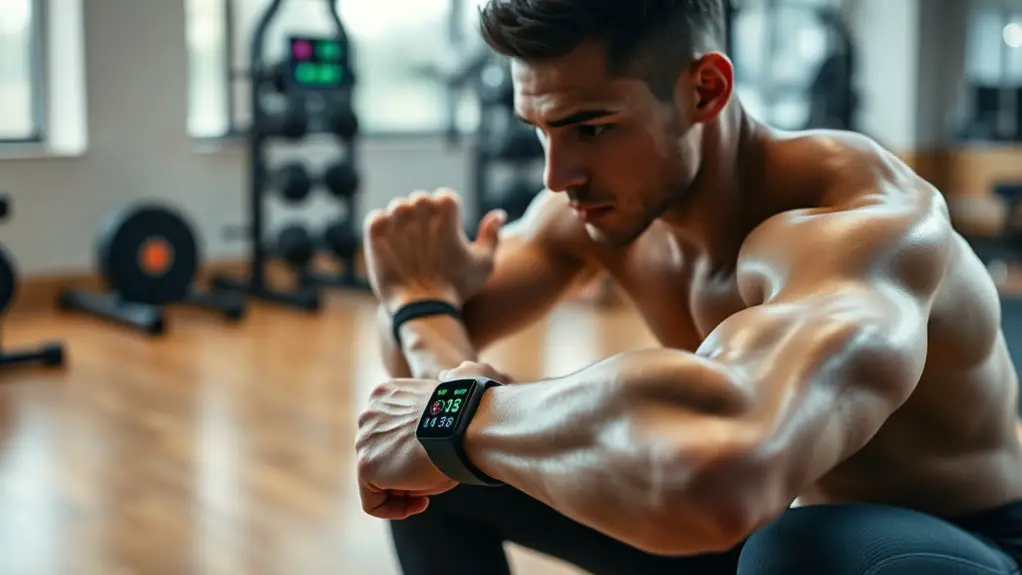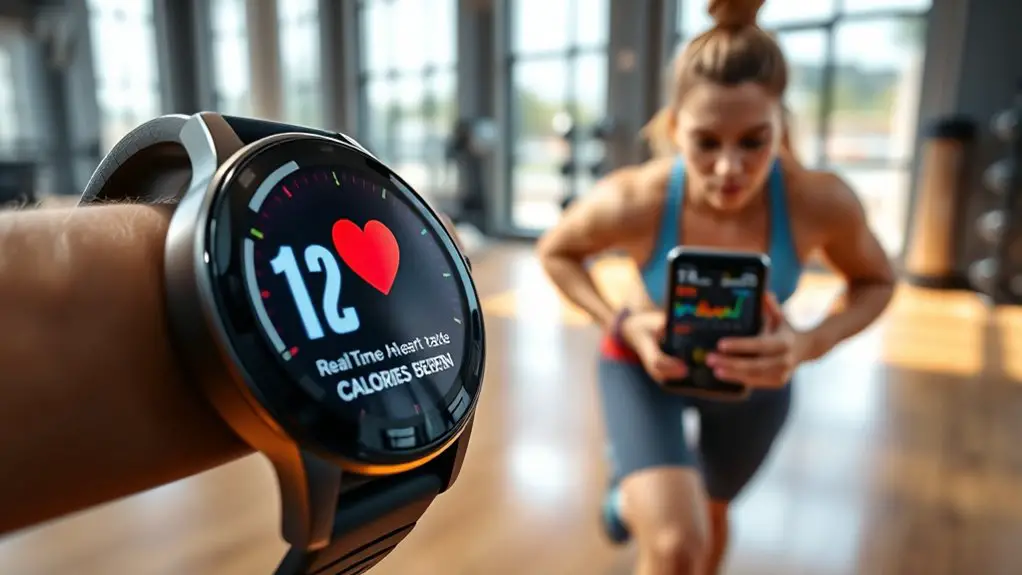How Wearable Technology Can Optimize Gym Performance

Wearable technology can greatly optimize your gym performance by providing real-time data that tracks key metrics like heart rate, calories burned, and activity levels. This instant feedback lets you adjust your workouts on the fly, enhancing efficiency and safety. By setting achievable goals and monitoring progress, you’ll stay motivated and accountable. Plus, integrating wearables with fitness apps can further personalize your training experience. Discover how to select the best wearables for your specific fitness needs.
Understanding Wearable Technology in Fitness

When you step into the gym, the right tools can greatly enhance your workout experience, and that’s where wearable technology comes into play. As fitness trends continue to evolve, technology integration has become essential for optimizing performance. Wearable devices like fitness trackers, smartwatches, and heart rate monitors offer real-time data, helping you to tailor your workouts more effectively. These gadgets can track your heart rate, calories burned, and even your sleep patterns, giving you a thorough view of your health.
Key Metrics Tracked by Wearable Devices
When you’re working out, tracking key metrics can greatly enhance your performance. Wearable devices monitor your heart rate, caloric burn, and overall activity level, providing insights that can help you optimize your routines. Understanding these metrics not only keeps you motivated but also guides you toward achieving your fitness goals more effectively. Additionally, knowing your recommended daily caloric intake can help you make better dietary choices to complement your workouts.
Heart Rate Monitoring
Although you might be focused on lifting weights or perfecting your cardio routine, heart rate monitoring plays an essential role in optimizing your performance. By tracking your heart rate variability (HRV), you can gain insights into your body’s recovery and readiness for intense workouts. A higher HRV often indicates better recovery, while a lower HRV may suggest fatigue. Additionally, monitoring your heart rate during exercise helps you gauge training intensity, ensuring you’re working within the ideal zones for fat burning or cardiovascular improvement. This data allows you to adjust your workouts in real-time, preventing overtraining and maximizing results. Ultimately, understanding your heart rate metrics empowers you to train smarter, enhancing both endurance and strength in the gym.
Caloric Burn Tracking
Caloric burn tracking is a game-changer for gym enthusiasts looking to maximize their workouts. By monitoring your caloric expenditure in real-time, wearable devices give you valuable insights into your fitness analytics. This data helps you tailor your exercises to meet specific goals, whether that’s weight loss, muscle gain, or improved endurance.
Here’s a quick look at how different activities affect caloric burn:
| Activity | Duration (mins) | Estimated Calories Burned |
|---|---|---|
| Running | 30 | 300 |
| Cycling | 30 | 250 |
| Weightlifting | 30 | 200 |
| Yoga | 30 | 150 |
Utilizing this information allows you to make informed decisions, ensuring each workout counts toward your fitness journey.
Activity Level Assessment
Understanding your activity level is just as important as tracking caloric burn, and wearable devices excel at monitoring key metrics that reflect your overall performance. With activity tracking features, these gadgets provide valuable insights into your daily movements, helping you assess your fitness levels more accurately. Metrics like step count, heart rate variability, and active minutes are essential for thorough fitness assessments. They not only highlight your workout intensity but also indicate how well your body recovers. By analyzing these metrics, you can identify patterns, set realistic goals, and adapt your training regimen accordingly. This data-driven approach empowers you to optimize your gym performance and guarantees you’re making the most of your time spent working out.
Benefits of Real-Time Data During Workouts
When you’re in the gym, having real-time data at your fingertips can greatly enhance your performance. It allows you to make immediate adjustments based on your body’s response, ensuring you get the most out of every workout. Plus, tracking your progress in real time can boost your motivation, helping you stay committed to your fitness goals.
Enhanced Performance Monitoring
As you push your limits in the gym, real-time data can transform your workout experience, offering insights that help you optimize performance and achieve your fitness goals. Enhanced performance monitoring through wearable technology allows you to track metrics like heart rate, calories burned, and workout intensity with impressive data accuracy. This immediate feedback not only keeps you motivated but also helps you understand your body’s responses to different exercises. By focusing on your heart rate zones, you can guarantee you’re training effectively, maximizing your efforts. Plus, an improved user experience means you can easily access and analyze this data, allowing for more informed decisions about your training regimen. Ultimately, this leads to more efficient workouts and better results.
Immediate Adjustments and Insights
While you’re pushing through that final set, the ability to make immediate adjustments based on real-time data can greatly enhance your workout efficiency. Wearable technology provides real-time feedback on your heart rate, form, and muscle engagement, allowing you to tweak your routine on the fly. For instance, if your heart rate spikes too high, you can reduce intensity or take a breather, preventing burnout or injury. Similarly, if your form isn’t ideal, instant adjustments can help you correct it, ensuring maximum effectiveness. This immediate feedback loop not only enhances your performance but also improves your understanding of your body’s limits, leading to safer and more productive workouts. Embracing these insights transforms your gym sessions into targeted, efficient training experiences.
Progress Tracking and Motivation
Real-time data not only helps you make immediate adjustments during workouts but also plays a significant role in tracking your progress and boosting motivation. With wearable technology, you can receive instant feedback that encourages you to push through barriers. Here are some benefits of real-time data for progress motivation:
- Visual Progress: See your improvements over time, reinforcing your commitment.
- Goal Setting: Set achievable milestones based on data insights.
- Instant Feedback: Make adjustments on-the-fly for better performance.
- Accountability: Wearable encouragement keeps you accountable to your fitness goals.
- Enhanced Motivation: Celebrate small victories that keep your spirits high.
Choosing the Right Wearable for Your Goals
How do you know which wearable technology will best support your fitness journey? Start by identifying your fitness goals—whether it’s weight loss, muscle gain, or endurance. This will guide your choice of device features. Look for wearables that offer heart rate monitoring, GPS tracking, or specialized workout modes tailored to your aspirations.
Next, consider your user preferences; do you favor a sleek design or a rugged look? Brand comparisons can help you weigh quality and customer reviews, while price ranges can vary greatly based on features and technology advancements.
Don’t forget about compatibility options with your smartphone or other fitness apps, as this will enhance your experience. Ultimately, your choice should reflect a balance of style choices and functionality that aligns with your goals, ensuring you stay motivated and engaged on your fitness journey.
How Heart Rate Monitors Boost Training Efficiency

Heart rate monitors are game-changers for your workouts, offering real-time tracking that helps you understand how hard your body is working. By identifying your personalized training zones, you can optimize your sessions to boost efficiency and reach your goals faster. This technology empowers you to make informed decisions, ensuring you train at the right intensity for maximum results.
Real-Time Heart Rate Tracking
While many athletes train diligently to achieve their fitness goals, maximizing performance often hinges on one essential factor: heart rate monitoring. Real-time heart rate tracking through wearable technology offers insights that can enhance your training efficiency. By leveraging wearable accuracy, you can better understand your heart rate variability and adjust your workouts accordingly. Here’s how it can benefit you:
- Maintain ideal intensity: Stay in the right heart rate zone for your goals.
- Prevent overtraining: Monitor your heart rate to avoid burnout.
- Enhance recovery: Track your heart rate variability to assess recovery needs.
- Boost motivation: Real-time feedback can encourage you to push harder.
- Personalize workouts: Adjust your training based on immediate heart rate data.
Embrace this technology for smarter training!
Personalized Training Zones
Understanding your heart rate is just the beginning; the real magic happens when you harness that data to create personalized training zones. By identifying your ideal heart rate ranges, you can design personalized workouts that adapt to your fitness level and goals. These zones—ranging from fat-burning to peak performance—allow you to train more efficiently and effectively.
With your heart rate monitor, you can engage in adaptive training, adjusting intensity in real-time to maximize results. Instead of guessing your effort, you’ll know precisely when to push harder or ease off, preventing burnout and promoting recovery. This targeted approach guarantees every workout is optimized, leading to faster progress and better performance in the gym. Embrace personalized training zones to elevate your fitness journey!
Tracking Recovery and Sleep for Optimal Performance
Here are some recovery strategies you might consider:
- Sleep Tracking: Use wearables to monitor sleep patterns and duration.
- Active Recovery: Incorporate light exercises like walking or yoga on rest days.
- Hydration: Stay hydrated to guarantee optimal muscle recovery.
- Nutrition: Fuel your body with balanced meals rich in protein and nutrients.
- Mindfulness: Practice relaxation techniques to reduce stress and improve sleep quality. Additionally, engaging in activities like light exercises can help maintain physical fitness during recovery.
Integrating Wearables With Fitness Apps

When you integrate wearables with fitness apps, you access a wealth of data that can greatly enhance your training experience. This connection provides real-time insights into your performance, heart rate, and calories burned, allowing you to make informed decisions during workouts. However, you might encounter data synchronization issues that can hinder this seamless experience. It’s essential to guarantee that your wearable device and app are properly synced; otherwise, you may miss out on valuable metrics.
Additionally, app compatibility concerns can arise when trying to connect different devices. Not all wearables work flawlessly with every app, so it’s wise to research compatibility before making a purchase. By addressing these potential hurdles, you can fully leverage the powerful insights wearables provide, ultimately optimizing your gym performance and helping you reach your fitness goals more effectively.
Setting and Achieving Fitness Goals With Wearable Tech
Setting and achieving fitness goals has never been easier, thanks to wearable technology. These devices empower you to implement effective goal setting strategies and track your progress in real time. Here are some ways wearable tech can help you stay on track:
Wearable technology simplifies fitness goal achievement, enabling real-time tracking and effective strategies for success.
- Set SMART goals: Specific, Measurable, Achievable, Relevant, Time-bound targets keep you focused.
- Monitor heart rate: Understanding your heart rate zones helps optimize workouts and recovery.
- Track daily activity: Wearables track steps, distance, and calories burned, providing a holistic view of your activity level.
- Set reminders: Timely reminders for workouts or hydration keep you accountable throughout the day.
- Review performance data: Regularly analyzing your stats helps you adjust your goals and strategies as needed.
Overcoming Common Challenges With Wearable Devices

While wearable technology offers numerous advantages for enhancing gym performance, users often encounter challenges that can hinder their experience. To make the most of your devices, it’s important to address these common issues:
| Challenge | Considerations |
|---|---|
| Data Accuracy | Verify your device calibrates correctly and provides reliable readings. |
| Device Compatibility | Check if your wearable syncs seamlessly with other fitness apps and devices. |
| User Comfort | Select a device that fits well and doesn’t interfere with your workouts. |
| Battery Life | Look for wearables with long-lasting batteries to avoid interruptions. |
| Privacy Concerns | Be aware of how your data is used and choose devices with robust privacy policies. |
The Future of Wearable Technology in Fitness
As the fitness landscape continues to evolve, wearable technology is poised to play an even more integral role in how you train and track your progress. Future innovations are set to revolutionize your workouts, making them smarter and more effective. Here are some wearable trends to watch for:
- Advanced biometric sensors that track hydration, stress levels, and more.
- AI-driven coaching that personalizes your training based on real-time data.
- Augmented reality integrations for immersive workout experiences.
- Enhanced recovery tools that monitor sleep quality and muscle recovery.
- Community features that connect you with fellow fitness enthusiasts for motivation.
These trends not only enhance your performance but also create a more engaging fitness journey. As you embrace these advancements, you’ll find that achieving your goals becomes more attainable, making the future of fitness exciting and full of potential.
Frequently Asked Questions
Can Wearable Devices Be Harmful to My Health?
You might think wearable devices are the crown jewels of health tech, but they can have health risks too. While most devices are safe, concerns about device radiation do exist. Prolonged exposure might lead to issues like headaches or skin irritation in some individuals. It’s essential to stay informed and monitor how your body reacts to these gadgets. Balancing benefits and risks is key to ensuring your health remains a top priority.
How Do I Clean and Maintain My Wearable Device?
Cleaning and maintaining your wearable device is essential for its longevity and performance. Use soft, lint-free cloths for cleaning, and avoid harsh chemicals. For stubborn grime, a mixture of mild soap and water works well. Regularly check for software updates to keep your device running smoothly. Additionally, consider removing it during intense workouts to reduce sweat buildup. Following these cleaning methods and maintenance tips guarantees your device stays in top shape.
Are There Privacy Concerns With Fitness Wearables?
When you think about privacy concerns with fitness wearables, you might consider data security and user consent. Are your personal stats safe? Are you fully aware of what you’re sharing? It’s essential to read privacy policies and understand how your data’s used. Many devices require your consent to collect and share information, so it’s important to stay informed. Protecting your privacy means being proactive and asking the right questions about your wearable tech.
Can Wearable Technology Track Outdoor Activities Accurately?
Absolutely, wearable technology can track outdoor activities accurately, especially with built-in GPS. When you’re running or cycling, these devices provide precise GPS accuracy, allowing you to monitor your distance, speed, and route. They also capture outdoor metrics like elevation gain and heart rate, giving you a thorough view of your performance. By analyzing this data, you can set goals and improve your outdoor workouts, making your fitness journey more effective and enjoyable.
What Is the Lifespan of a Typical Wearable Fitness Device?
The lifespan of a typical wearable fitness device varies, but you can expect around 2 to 5 years. Battery longevity plays an essential role here; as batteries age, they may not hold a charge as well. You might also find that device upgrades become necessary to keep up with software advancements or improved features. Regularly checking for updates and considering when to replace your device can enhance your fitness tracking experience considerably.





